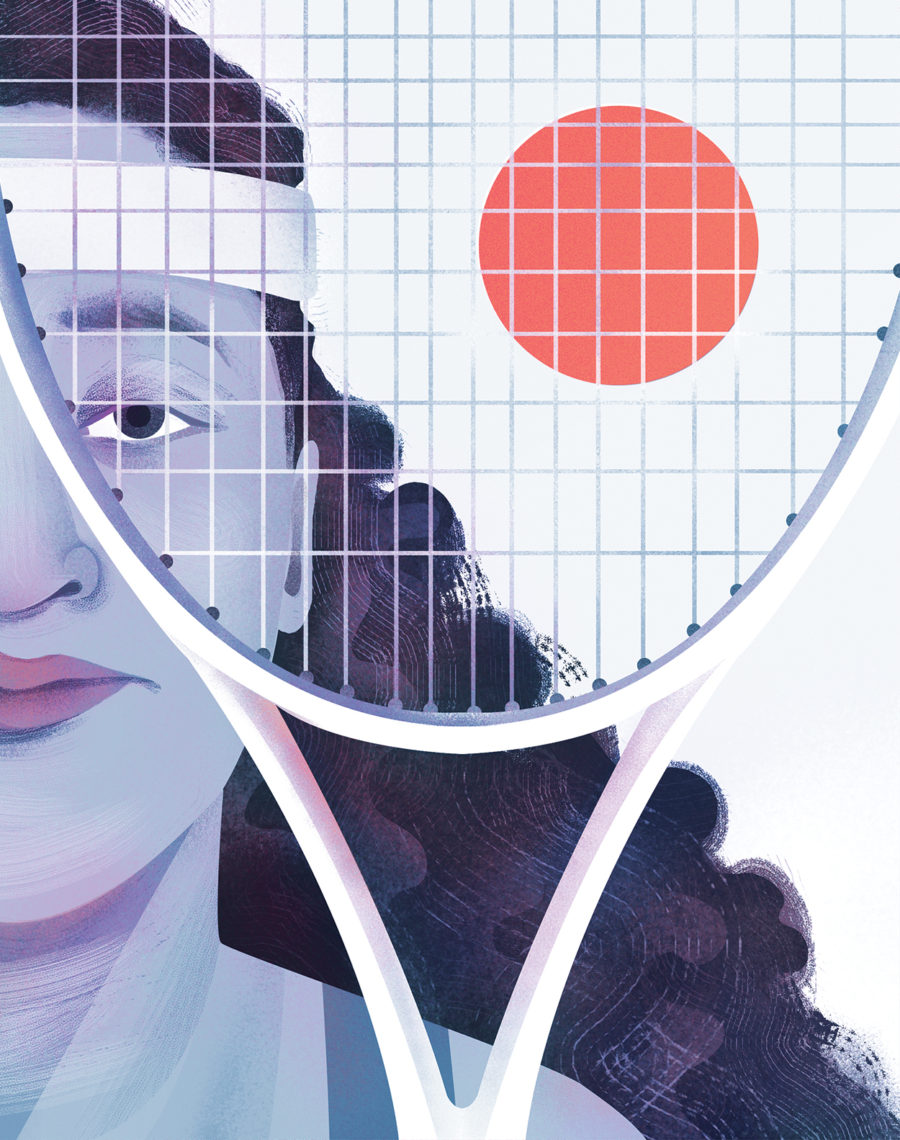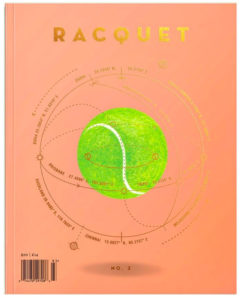By Louisa Thomas Illustrations by Bee Johnson
A tennis player has a home but is hardly ever there. At times it can seem that she lives in hotel rooms, in suitcases, in the pages of her passport. She moves from Moscow one week to Singapore the next; she travels from Miami to Rome. Perhaps she has a training base in Monte Carlo, where there are the tax breaks, or she has a house in Los Angeles, where there is sun.
But she is not without a country. It follows her everywhere. Her flag is waved in the stands and painted on the faces of her fans; it appears next to her score in the bottom corner of the television screen. Her nationality is reflected in the gaggle of press that follows her from country to country, round to round. It is manifest in her speech and sometimes even in her playing style. For some players it doesn’t matter much. Her allegiance can be an accident of birth, or the result of a federation offering the most wild cards, better coaches, money. For others, it can be a source of pride. It can offer an identity, a sense of belonging. Tennis can be lonely at times.
For Naomi Osaka, it is a little more complicated. On the court, she represents Japan. Her last name is the name of the city where she was born, the second-largest city in the country; it is her mother’s ancestral land. But when people see her, they are often surprised to learn she is Japanese, because her father is Haitian, and she is half black. When she went to her first few tournaments, she told me, “I could see the shock on people’s faces.”
“Japan is a country which is, of course, an isolated island, and most people have very few chances to talk to foreigners or people of other races,” Aki Uchida, a Japanese freelance tennis writer, explained. “It’s totally different from the U.S.”
When Osaka spoke, the shock on people’s faces grew. Her voice, soft and high, is the voice of a shy teenager from Florida, where she has lived most of her life. She says she took it with good humor. “In America, it was sort of funny,” she said. “When I went to Japan, it was ten times more funny.”
It may have been hilarious. But there were moments that were clearly unnerving. Success brings attention, attention brings demands. Osaka was expected not only to represent Japan but also to speak to it. At the Australian Open, she made it to the third round, upsetting a top 20 player along the way. The huge Japanese press corps, there to cover Kei Nishikori, one of the top men’s players and a major celebrity in Japan, filled the seats of her press conference. The reporters who covered tennis regularly were aware of her, but many outlets were interested in her for the first time.
The handler began the press conference by asking for questions in English first, followed by Japanese. She looked startled. “English only?” She didn’t know how to speak Japanese.
She wants to learn. Her goal for the off-season is to study the language, to speak it at home and maybe take a class. Her comprehension is good, and her speech is getting better. It is not easy, and not only because learning a new language rarely is. “I’m extremely shy,” she said when I asked if there was anything she wants people to know about her. She has started making more of an effort to take questions in Japanese, and the Japanese press has made an effort to speak English to her. She is touched by the gesture. “It’s nice to see them going out of their way,” she said.
It’s easy to see why they would try to get to know her. Osaka is ranked 40th in the world, and she looks likely to rise—perhaps quickly. She is 19 years old, the second-youngest player in the top 100, and only two months older than the youngest, Ana Konjuh, who is ranked a spot behind her. And she is charismatic—cheerful, sweet, open about her strengths and faults, honest about her ambition. The WTA named her the tour’s 2016 Newcomer of the Year.
Osaka made the third round of all three majors she played this year, her first full year as a senior. (She missed Wimbledon due to injury.) And she might have made it further at the U.S. Open. Playing Madison Keys, a top 10 player, in Arthur Ashe Stadium, Osaka was up 5–1 in the third set before she tightened terribly, letting Keys back into the match. Serving at 5–4, 30–30, she had an easy forehand volley that likely would have brought her match point. She slapped it wildly, and when it ricocheted out, she let out a piercing scream of horror that rose in register as she realized what she had done. The crowd, the largest in tennis, was ecstatic, cheering loudly against her—for Keys, as if Osaka was not also playing in the country of her home.
Osaka understands, she says, even though the crowd could be “frustrating.” She has two passports but only one flag next to her name, and the American crowd cheered for the one with the American flag. It wasn’t her choice; her father, who had been her coach, made the decision, on the logic that the Japanese Tennis Association was offering her more support than the United States’. She understands that, too. And so far it is working out. Through the JTA, after the U.S. Open, she began working with David Taylor, who used to coach Grand Slam winner and former top 10 player Samantha Stosur.
Osaka gives him talent to work with. She has some of the purest raw power in the game, a serve that she can use to dictate points and a whipping forehand swing that generates phenomenal racquet head speed. Even as a 16-year-old, she’d clocked forehands at over a hundred miles an hour. But Taylor brings her something, too. Since they have started to work together, before each match they make a plan. She is focused not only on playing her own game, but on what her opponent might do and how she can adjust, and what patterns she can fall back on when everything else falls apart. They haven’t started working on her technique yet, but Osaka imagines that will happen too. “I think it’s just going to come as a surprise or something,” she said with a laugh.

After the U.S. Open, the WTA tour moved to Asia. In Tokyo, which Osaka calls her favorite city, she was a visitor, like the other players, living in the hotel, eating out. Only, these were her favorite restaurants, and there were the crowds who cheered for her.
Osaka can be self-conscious in the way that teenagers sometimes are, disarmingly forward about her shyness, says she’s fearful that people think she’s “mean” because of the narrow emotional range she tends to show on her face. But around this time, she began to open up to the public. During the Japan Women’s Open, she started a Twitter account. She tweets funny gifs, self-deprecating jokes; occasionally she tweets in Japanese. She tweeted a picture of a huge adidas ad of her in Tokyo, with a run of emoji hearts.
She seemed to be growing into herself as a player as well. The collapse at the U.S. Open could have haunted her, its memory a whisper in her mind that she could always lose, that no lead is ever safe. It is the unusual gift of top athletes that they can use losses not only to learn, but to motivate themselves. She thought about that collapse a lot during the Toray Pan Pacific Open, she said. Up 5–1 against Dominika Cibulkova, a former Grand Slam finalist who has had a stellar year, the pressure started getting to Osaka. She had a “horrible flashback to the U.S. Open,” she said after the match. For some players, the thought would have been self-fulfilling. But Osaka managed to use it to motivate herself. She would get down on herself, then think of that match in New York against Keys. “I didn’t want to repeat the same mistakes,” she said. She closed out the game and the match.
Osaka made it all the way to the final, where she lost to former No. 1 Caroline Wozniacki. What was as impressive as the depth of her run was the way she made it—not only using overwhelming power (she can break 120 miles per hour with her serve), but showing unusual composure. Against Elina Svitolina, a top 20 player, for instance, Osaka won nine of the 11 break points she faced—and, even more impressively, demonstrated her ability to adjust. In the first set, in which Osaka was blown out 1–6, she won only about a third of the rallies that lasted more than three shots. But in the deciding third set, she won more than half of the medium-length rallies—and an impressive 71 percent of rallies that lasted more than six shots.
For most of her young career, Osaka has admitted, she hit the ball “blindly.” She is learning to follow patterns, to exploit weaknesses, to anticipate the other player’s response. She would wait on the ball, be more patient, and when she finally unfurled an inside forehand that clipped the line, she would give a gentle fist-pump and a small suggestion of a smile. It would have been obvious to anyone who watched Osaka for a second that the key to beating the top players is playing with greater consistency. What was more surprising was Osaka’s own attitude about it. “It’s fun to hit winners,” she said. But the “funnest” part of tennis is outgrinding the grinders, winning the long rallies. If she can do that, she can do anything. “Then I know I can beat them at their own game,” she said. At the end of every victory, she bowed.
The bow was more than a way to acknowledge the crowd. It was a way to claim the country next to her name, to honor a tradition that isn’t quite her own. It makes a difference. People notice. “The way she bows, that’s really, really Japanese,” Uchida said. When I asked Uchida whether Osaka did it properly, she answered, “Yes. Very.”
And it makes a difference to Osaka as well. The resources that the JTA could offer are not the only reason Osaka thought her father had made a “good decision” in giving her allegiance to Japan. “I felt like it was going to be fun and interesting to do that,” she said.
So it is, for her, not only something she is born into. She is feeling her way into it, performing the identity as much as inhabiting it. Japan suits her, she said. “I think the fact that everyone’s really polite, and the fact you can ask anyone a question and they’ll probably go out of their way to help you. It’s really clean over there. The food is really nice.” She likes watching samurai movies on television, or she’ll put an episode of Nobunaga Concerto on her laptop while she’s on the road. “Every time I watch one movie or drama, I learn something new about Japan,” she said. “I’m really trying to learn a lot.”



